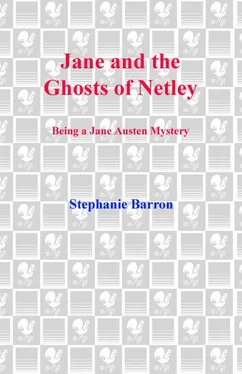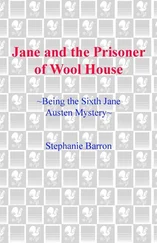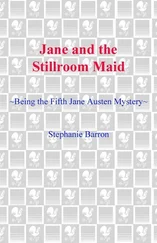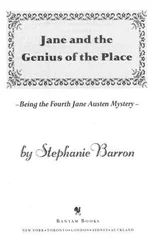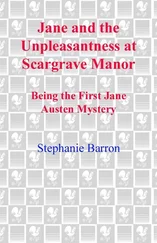Stephanie Barron - Jane and the Ghosts of Netley
Здесь есть возможность читать онлайн «Stephanie Barron - Jane and the Ghosts of Netley» весь текст электронной книги совершенно бесплатно (целиком полную версию без сокращений). В некоторых случаях можно слушать аудио, скачать через торрент в формате fb2 и присутствует краткое содержание. Жанр: Исторический детектив, Иронический детектив, на английском языке. Описание произведения, (предисловие) а так же отзывы посетителей доступны на портале библиотеки ЛибКат.
- Название:Jane and the Ghosts of Netley
- Автор:
- Жанр:
- Год:неизвестен
- ISBN:нет данных
- Рейтинг книги:4 / 5. Голосов: 1
-
Избранное:Добавить в избранное
- Отзывы:
-
Ваша оценка:
- 80
- 1
- 2
- 3
- 4
- 5
Jane and the Ghosts of Netley: краткое содержание, описание и аннотация
Предлагаем к чтению аннотацию, описание, краткое содержание или предисловие (зависит от того, что написал сам автор книги «Jane and the Ghosts of Netley»). Если вы не нашли необходимую информацию о книге — напишите в комментариях, мы постараемся отыскать её.
rings true as always.
Jane and the Ghosts of Netley — читать онлайн бесплатно полную книгу (весь текст) целиком
Ниже представлен текст книги, разбитый по страницам. Система сохранения места последней прочитанной страницы, позволяет с удобством читать онлайн бесплатно книгу «Jane and the Ghosts of Netley», без необходимости каждый раз заново искать на чём Вы остановились. Поставьте закладку, и сможете в любой момент перейти на страницу, на которой закончили чтение.
Интервал:
Закладка:
“My brother’s, perhaps — but not mine.” Guilt, powerful guilt, over the false pretences under which I had pursued Sophia Challoner’s friendship surged again in my heart.
“Indeed, I may say that I only remained at Netley another night — extraordinary conduct, in the absence of the Lodge’s mistress — to be certain that Mr. Ord was sped on his way.”
It seemed, then, as the lady stood before the gilt mirror in Sophia Challoner’s dining-room, that she desired to impart a confidence; but the drawingroom door burst open, and Frank reappeared.
“The wound is stitched, but continues seeping,” he informed us brusquely; “the surgeon believes there is not much time.”
“You mean—?” I set down my glass of brandy unsteadily. “But cannot we send for Dr. Jarvey? Or take him directly in the gig to East Street now?”
“No, Jane. He is too weak; if the wound does not kill him, movement will.” Frank’s gaze was merciless.
“He is asking for you. Both of you.”
I gazed at Maria Fitzherbert, but she declined to take precedence. I may say that I ran to him. He was propped a little on a pillow, and his eyes — though heavy-lidded — were yet alert. A clean bandage stretched from collarbone to ribs; but a dark aureole of blood had already blossomed there. He held out his hand, and I seized it in my fingers. Maria Fitzherbert sank down in a chair.
“Maria,” he said.
“Yes, Harry?”
“Your son is... safe... no word of the truth—”
“How long have you known?” she demanded quietly.
He shook his head. “Guessed. He has the look... of the Prince — twenty years ago. .”
Twenty years ago, when Maria Fitzherbert had been happy at Kempshott Park. Understanding fell upon me like a dash of cold water.
She rose abruptly and walked away from us, to stand by the window seat where I had observed her working fringe — as placid, I had thought then, as a cow. What sacrifices this woman had endured! Two husbands and a son in the grave — all the scorching calumny of public comment over her liaison with the Prince — the loss of reputation — and then the most painful ordeal: the royal child sent out into the world, there raised by virtual strangers.
“Remembered how you admired Archbishop Carroll,” Lord Harold said wearily. “Found out that Ord’s family emigrated on the same ship to the Americas that Carroll took. Your work of course. Understood then. Does Ord know?”
She shook her head.
He clutched at my fingers — a spasm, perhaps, for the touch relaxed almost instantly. “Jane.”
“My lord.”
He smiled faintly, a curving of the lips; but the face was so haggard, and beaded with sweat. “You cry, dear? Waste. Should’ve married you years ago.”
I kissed his cold hand — my throat was too constricted for speech, and my heart beating wildly. “You must try, Lord Harold. You must rally!”
His grey eyes opened wide, and he gazed clearly at my face. “Promise me... you will write . Heroine—”
“What is writing compared to life, my lord?”
“All we have. Fool, Jane. Fool .”
“No, my love—”
But he was already gone.
THE END
Editor’s Afterword
The present volume of Jane Austen’s detective memoirs is distinct from the six manuscripts I have previously edited in that it concludes abruptly — without the sort of coda she often wrote, to assure her readers of the pleasant future in store for those whose lives she had followed. We know from her novels that Austen enjoyed happy endings; but one clearly eluded her here, as it so often did in matters of the heart.
The story that unfolds in Jane and the Ghosts of Netley is one that I find particularly absorbing, because I have long been a student of the illegal marriage between Maria Fitzherbert, Catholic commoner, and George, Prince of Wales (later George IV of England). In editing the present manuscript, Saul David’s Prince of Pleasure: The Prince of Wales and the Making of the Regency (Great Britain: Little, Brown, 1998) was extremely helpful. David outlines the history of James Ord, Fitzherbert’s putative son, and his rearing among the Catholic gentry of Maryland. Ord did become a member of the Jesuit order, and later confronted his friends with questions regarding his parentage that were only partially answered. Mrs. Fitzherbert, though she never publicly admitted her parentage of Ord, declined categorically to sign a document testifying that her marriage to the Prince had been without issue. She is believed to have borne the Prince a daughter as well, one Maryanne Smythe, who was passed off as a niece and eventually reared in Mrs. Fitzherbert’s household.
For those interested in religious issues of the period, Catholics in Britain and Ireland, 1558–1829, by Michael A. Mullett (New York: St. Martin’s Press, 1998), is instructive. For a history of the English and French in Portugal, I can recommend no finer work than Michael Glover’s The Peninsular War, 1807–1814 (London: David and Charles, 1974). Stephanie Barron
Golden, Colorado
March 2002
Примечания
1
A third-rate ship carrying 74 guns, this was the most common line-of-battle vessel and a considerable number were built during the Napoleonic Wars; by 1816, the Royal Navy possessed 137 of them. They weighed about 1,700 tons and required 57 acres of oak forest to build. — Editor’s note.
2
The opinion given here is a rough paraphrase of sentiments Jane first expressed at the age of sixteen in her History of England, by a Partial, Prejudiced, and Ignorant Historian. — Editor’s note .
3
Austen wrote the manuscript entitled Susan in 1798 and sold it to Crosby & Co. for ten pounds in the spring of 1803. The firm never published it, and Austen was forced to buy back the manuscript in 1816. It was eventually published posthumously in 1818 as Northanger Abbey . — Editor’s note .
4
The bosun’s chair was formed of a simple board, rather like the seat of a swing. Sailors used it when repairs aloft were necessary; but it was frequently employed to assist ladies up the side of a ship, as they could not be expected to mount rope ladders while wearing skirts. — Editor’s note.
5
The British army engaged the French at Vimeiro, Portugal, on August 21, 1808. It was the first British conflict on the Peninsula, and a decisive victory. — Editor’s note.
6
Wellesley was thirty-eight years old in 1808, and would make his career in the Peninsular War. He was eventually created the Duke of Wellington, and confronted Bonaparte for the last time at Waterloo in 1815. — Editor’s note.
7
Burnt orange. — Editor’s note.
8
The Whip Club was known after 1809 as the Four-in-Hand Club, and was comprised of a fashionable set of gentlemen who emulated the skill of public coachmen by handling the reins of four horses driven as a team. They met quarterly for group driving expeditions and wore white drab driving coats with numerous capes, over a blue coat and a striped kerseymere waistcoat in yellow and blue. Membership was based upon the skill of the driver and was thus highly exclusive. — Editor’s note.
9
Seamen in the Royal Navy were designated Ordinary or Able, depending upon their level of skill and experience. Able Seamen were paid slightly more than Ordinary. — Editor’s note.
Читать дальшеИнтервал:
Закладка:
Похожие книги на «Jane and the Ghosts of Netley»
Представляем Вашему вниманию похожие книги на «Jane and the Ghosts of Netley» списком для выбора. Мы отобрали схожую по названию и смыслу литературу в надежде предоставить читателям больше вариантов отыскать новые, интересные, ещё непрочитанные произведения.
Обсуждение, отзывы о книге «Jane and the Ghosts of Netley» и просто собственные мнения читателей. Оставьте ваши комментарии, напишите, что Вы думаете о произведении, его смысле или главных героях. Укажите что конкретно понравилось, а что нет, и почему Вы так считаете.
